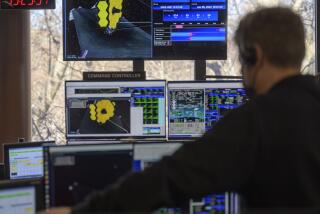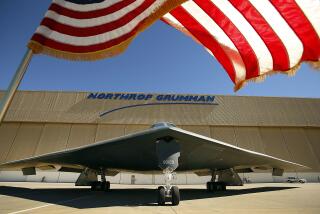Lockheed lobbies for F-22 production on job grounds
- Share via
WASHINGTON — Lockheed Martin Corp. is lobbying the Obama administration to buy additional F-22 fighter jets by arguing that continued production of the plane would preserve nearly 100,000 jobs across the country, including 19,500 in California.
Secretary of Defense Robert M. Gates and other officials have voiced skepticism over the F-22 program in the past, and disagreements over the future of the plane led to a shake-up in Air Force leadership last year.
But Larry Lawson, the F-22 program general manger for Lockheed Martin, said Tuesday that if the administration decided to continue production of the fighter, known as the Raptor, it would have a precise and immediate economic effect.
“Our point is, No. 1, this preserves jobs, and No. 2, it is immediate. You don’t have to develop anything,” Lawson said. “This is ‘shovel ready.’ ”
The F-22 program is directly responsible for 25,000 jobs at Bethesda, Md.-based Lockheed Martin and its major suppliers. But Lockheed officials say when jobs from sub-suppliers are added in, the F-22 program maintains 95,000 jobs in 44 states.
In California, the F-22 is responsible for 6,500 direct jobs and 13,000 indirect jobs at 262 locations, according to Lockheed. Parts produced in California include Raytheon Co.’s processor that serves as the brain for the plane’s avionics.
Like other military contractors, Lockheed has ensured broad political support for the F-22 by spreading the work across the country.
Chicago-based Boeing Co. assembles the aircraft’s aft section and wings in its Seattle plants. In Baltimore, Northrop Grumman builds the plane’s radar. In Connecticut, Pratt & Whitney builds the engine.
The new administration faces a March 1 deadline to keep the production lines open. Job losses would begin this year, with the majority in 2010, Lawson said.
The Air Force spent more than $62 billion researching, developing and procuring its first 183 F-22 fighter planes, or more than $300 million a plane. Additional planes cost less, about $142 million a copy.
The F-22 is often criticized as a Cold War weapon, of little use in conflicts such as Iraq and Afghanistan. The plane’s backers say it can evade Russian-designed anti-aircraft systems that are proliferating around the world. They say it also would preserve the superiority of the U.S. fighter fleet.
As Lockheed steps up its push for more F-22s, the Air Force has remained quiet. Gen. Norton A. Schwartz, the military branch’s current chief of staff, has expressed support for additional planes but has kept a lower profile than his predecessor, now-retired Gen. T. Michael Moseley.
Moseley was ousted last year after disagreements with Gates and others over the F-22.
“The Air Force is just trying to avoid getting whacked by Secretary Gates,” said Thomas Donnelly, a resident fellow at the American Enterprise Institute, a Washington think tank.
Gates said at a news conference Tuesday that no decision had been made about the F-22. The Pentagon must formulate a budget that “serves the nation best,” he said.
Donnelly, who has publicly advocated procurement of additional F-22s, said it was important to keep the production line going now -- rather than stopping and perhaps restarting later.
“We are coming to the end of the line,” he said. “If we terminate the line, I can’t imagine the company will spend the money to hold open a window that is pretty close to being shut.”
--
More to Read
Inside the business of entertainment
The Wide Shot brings you news, analysis and insights on everything from streaming wars to production — and what it all means for the future.
You may occasionally receive promotional content from the Los Angeles Times.







